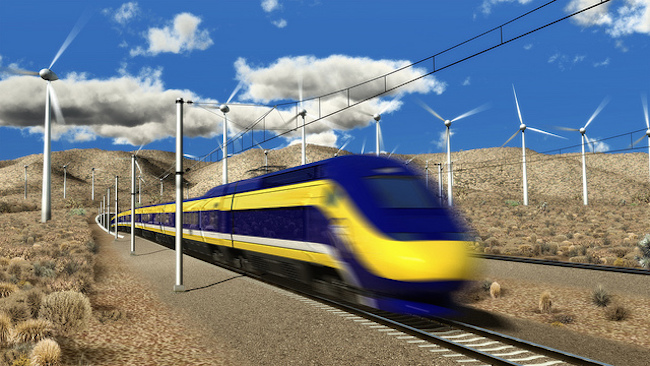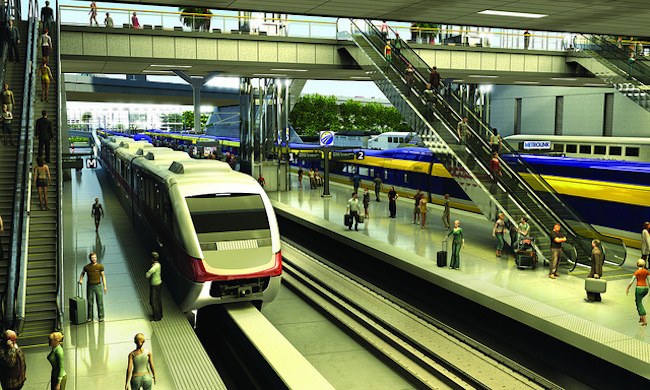California High-Speed Rail Construction To Start, Controversy Continues

The proposed trip between these two mega-regions will take under three hours and riders will experience speeds of over 200 miles per hour. The entire project will include track to Sacramento and San Diego, connecting Californians with 24 stations and 800 miles of rail.
“The stated purpose of the rail is to bring a new, more efficient technology for passenger transport to the U.S.” said Genevieve Giuliano, Senior Associate Dean for Research and Technology Director, METRANS. “It is to develop a more environmental friendly mode. It'll reduce greenhouse gasses, give people another option, promote dense development around the station, help us to not expand airports and get cars off the road.”
Whether or not the high-speed rail system will accomplish these objectives is up for debate.
By 2050, California is expected to have a population of over 50 million. These additional people will add demand to an already stressed transportation system.
The California High-Speed Rail Authority (CHSRA) claims the project will help alleviate the future population’s transportation burden by providing consumers new statewide rail system option that will connect Northern and Southern California.
“As California continues to grow, we have to account and plan for that capacity,” said Lisa Marie Alley, Deputy Director of Public Affairs, California High-Speed Rail Authority. “We don't have a way right now to add more runways or airports or double deck our freeways.”
SEE ALSO: California High-Speed Rail On Track
The high-speed rail system’s success banks on the proposed population growth of California and CHSRA’s plan to capture part of the current air and vehicle travel. Whether or not CHSRA can corner enough of the market to become successful and economically viable is uncertain.
“About 85-95% of all long distance travel in this range is in the private vehicle, and has been for many decades,” said Giuliano. “So the most common way anybody gets between Northern and Southern California is in their personal cars. Second is in air. In particular at 400 miles, because of the speed differential. Air traffic is 10 percent of the market, and rail is less than 1 percent. Even if we see 10 percent of people that are currently in airplanes using the high-speed rail, that's not a lot.”
The CHSRA plans to compete with car traffic and airline flights by offering a faster, more-reliable form of transportation that is comparable price-wise while having a more enjoyable user experience.
“We know we can get travel time under three hours, when you figure in the time to check in, go through security, get your bags, be on your flight, possibly the flight is delayed and land and go through all of that,” said Rachel Kesting, Information Officer, California High-Speed Rail Authority. “We’re competitive with short haul flights from Los Angeles to San Francisco.”
While in theory this sounds appealing, in practice the proposed trip time may be slightly overstated.
With policies and procedures still in development, security may not be as removed as when taking the Metrolink or Amtrak. Travel to and from the station must be evaluated as well.
“Currently people assume we won’t have security or TSA stops on the train, I think that’s ludicrous—there have been far more train related terrorist activities than airplane related ones,” said Lisa Schweitzer, Associate Professor, Sol Price School of Public Policy. “I don’t believe that will be managed any better than existing TSA practices. The ‘getting [to the station]’ part is an issue, but it’s an issue for both air and train travel.”

Price estimates for a high-speed rail ticket are expected to fluctuate, but will be comparable to the price of an airline ticket. The main group of riders that will take advantage of this service will be business class, inner-city travelers—people who are capable of buying seats on an airplane.
“I think you're going to see a diverse group of riders, it provides business travelers a new mode of transportation because you won't have to show up an hour and a half early,” said Alley. “You will have wifi, you're going to have the luxury like they do in Japan and Italy to work while you're traveling, you're also going to see an increase ridership of the millennial generation because people relying less on cars because they don't want to pay for gas and insurance, so this is an alternative mode of travel.”
For business travelers, high-speed rail makes sense if the travel time is as advertised. In an industry where time is money, a flight still may be more feasible. But for leisure travelers, the market is still questionable.
“The leisure market—the family vacation, visit your parents market—will overwhelmingly stay in vehicles because it's really expensive to buy four fares for your family to ride the train or fly in an airplane so the leisure market is much more cost effective in a full car,” said Giuliano. “You're left with business travelers and the latest numbers I've heard is they're anticipating the market to be about 5% of former air transport passengers and that's not much.”
By adding a new option to California’s transportation market, competition will become a huge determinant in ridership statistics. Assuming the time differential is comparable, cost may become the deciding factor on who rides the new system.
“We can't predict where fuel prices are going to go, we have ideas about how quickly cars are becoming more efficient, but you never know,” said Giuliano. “We don't know how airlines will compete but I can't imagine the future Southwest Airlines not competing. So people are going to look at the price, the time to get there and the convenience when deciding.”
If all goes to plan, the high-speed rail system will be cleaner than any other form of long-distance mass transportation in California today.
The construction process is subject to NEPA and CEQA standards, with CHSRA exceeding some of the state and federal requirements and the whole system will be powered completely by renewable energy once up and running.
“For every one acre of farmland we use, we'll be preserving or protecting one acre of farmland,” said Alley. “As we build the system, we're recycling up to 100 percent of the buildings we demolish. We're using Tier 4 construction equipment, which is the highest rated construction equipment in the US.. and releases the fewest emissions.”
With concerns over the environment escalating over the past several decades, a train powered by renewable energy is an enticing feature.
READ MORE: 5 Green Tech Ideas We Like At GloSho 2014
But again, real steps in protecting the environment will only occur if enough consumers leave their current mode of transportation in favor of the high-speed rail.
“Without some mechanism for carbon pricing, there will be a marginal impact,” said Schweitzer. “Yes there are fewer people taking fewer flights, but it may not amount to $68 billion in improvements for the environment.”
The biggest controversy surrounding the high-speed rail project is where California will get the money to build and operate the system.
In 2008, voters approved Proposition 1A—the High Speed Passenger Train Bond Program. The Proposition guaranteed almost $10 billion in bond money to use in the construction of a statewide high-speed rail system.
Since then, several of the key points voters approved have been changed, including overall cost. Many believe voters should have another chance to vote on this fundamentally “different” project.
“If I had a chance to vote on this today, I would vote against it. The people of California have voted on a system that they're not going to get,” said Giuliano. “They voted for a system that would cost 30 billion dollars, pay for itself, pay all of it's operating costs, and get you there in two hours. What we have now is $68 billion, which I personally don't believe, it's only going to go up from there.”

Around $3.3 billion has been guaranteed in federal grant funds, and 25 percent of California’s cap-and-trade revenue will be applied yearly as well. The CHSRA has planned to rely heavily on investments from private sectors to fund the rest of the project.
Critics argue the project’s numbers don’t promote private investment, and California will have to account for the money itself.
“Private industry is about positive revenue streams, there is no motivation to get involved with this until we are basically painting the doors in SF and Los Angeles,” said Schweitzer. “The money is coming from California tax payers, and projects of this size are big enough that they can consume the budgetary resources of other things. This is a very big and complicated project, and it’s not a single project, this is a system, and we’ll be fortunate if we get it in at $68 billion.”
An important feature of the high-speed rail project is its mandate to include the local economy in the construction of the project. Not only will the project generate construction jobs, but there will be more people needed to operate the system once it’s completed.
“We have a 30 percent mandate for certified small business or disadvantaged business, which includes minority, woman owned businesses and disadvantaged or veteran businesses,” said Kesting. “30 percent of our subcontractors have to fall within these categories. We are actively reaching out to help small business be part of the project.”
By 2022, the IOS, or initial operating sections, will open be between Merced and the Burbank airport. This is an interesting business plan by CHSRA, given the lack of the market in the middle of the state.
“If you really wanted to show the market for high-speed rail in California, you'd build it from L.A. to San Diego,” said Giuliano. “That's a huge corridor, it's 100 miles, the air market is limited, the trains are full today, there's already the infrastructure at either end because there's a lot of train traffic, so you have a much more developed potential market in the favorable distance for high speed rail.”
The issues surrounding the California high-speed rail system boil down to price, time and quality.
With so many uncertain variables, it may or may not be competitive in the future transportation market. With over 15 years left before completion, only time will tell if California has made a smart, lasting investment.
“High speed rail is nice, it’s useful, but is it the be all end all that it’s advocates have said it is? No.” said Schweitzer. “It’s another way of getting around, the systems are expensive, but they’re quality transportation. If Californians want that, then democratically they should have it.”
Reach Editor-at-Large Michael Nystrom here. Follow him on Twitter here.



